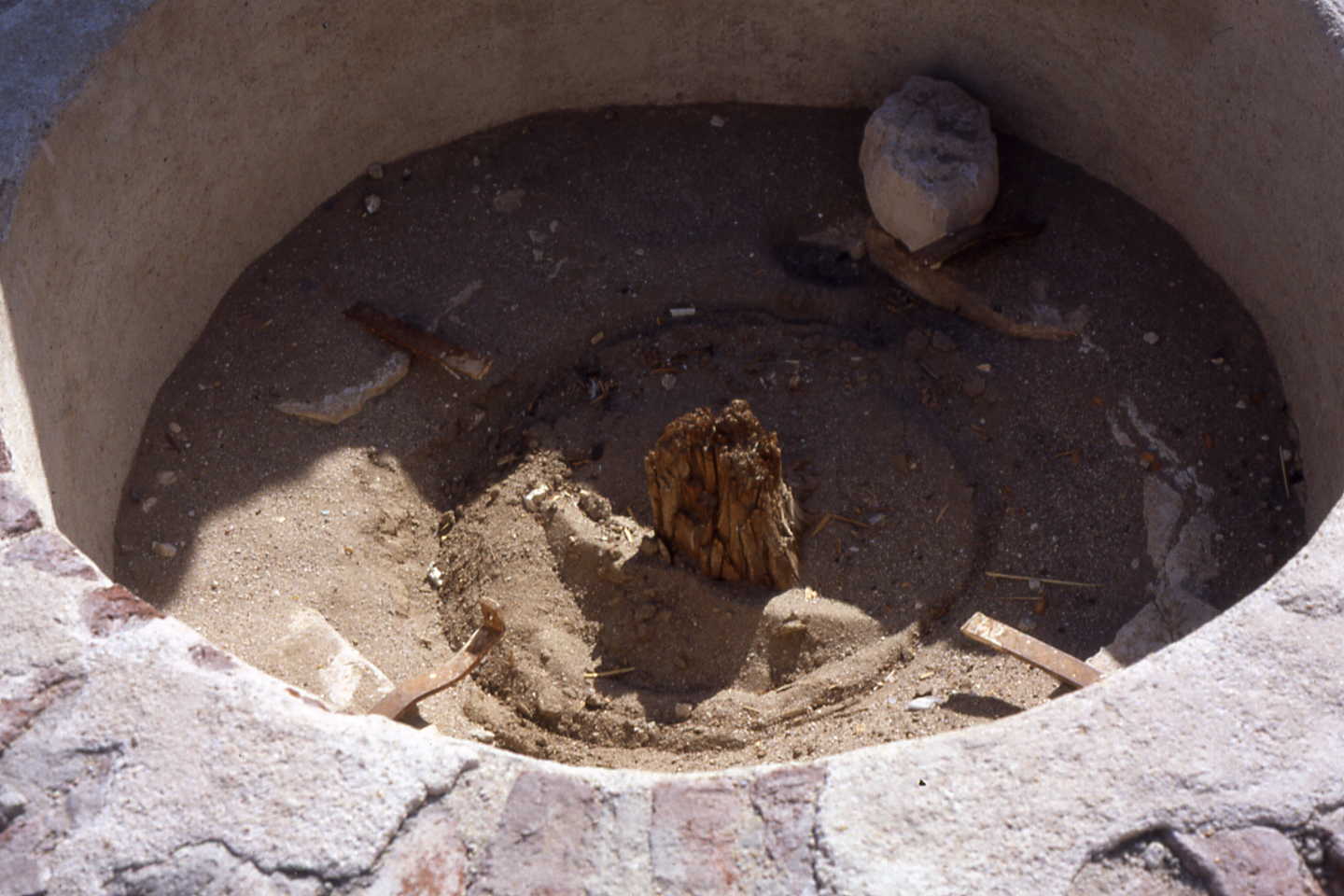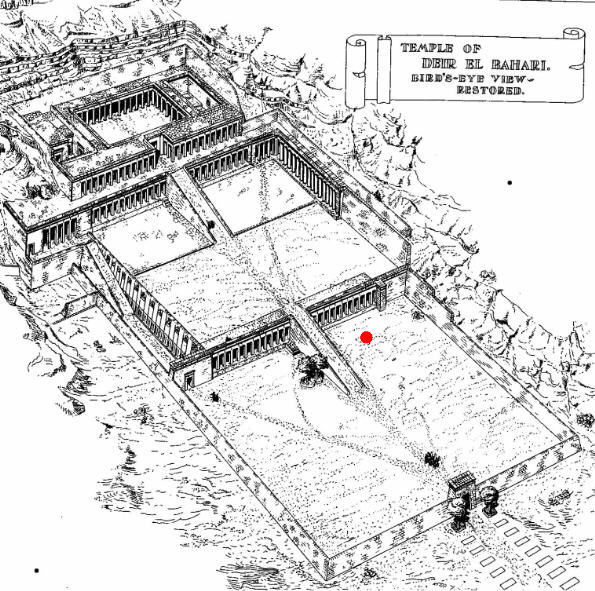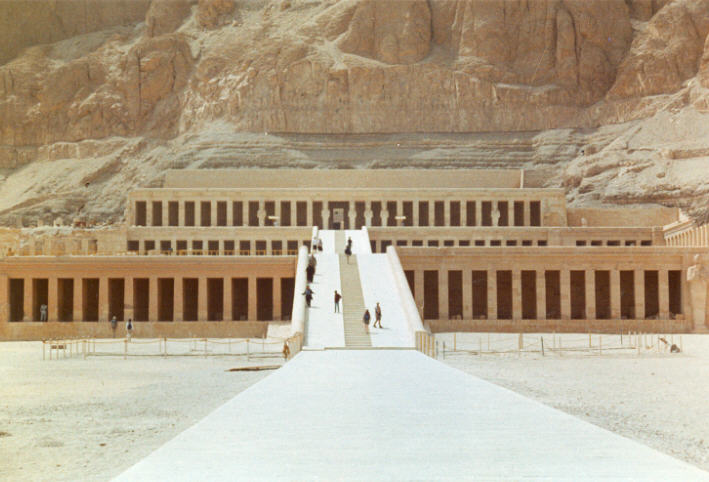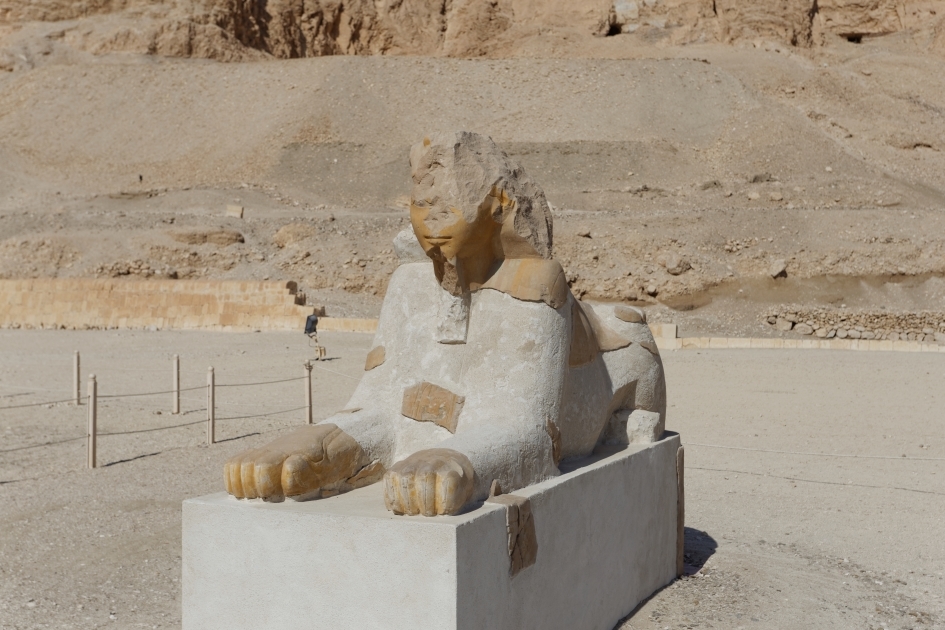|
Garden and Pools |
update:
28.11.2015
|
| Like many Egyptian temples also the temple of Hatshepsut at
Deir el-Bahari had - a rather modest - garden with two pools. Probably, the
neighboring temple of Mentuhotep Nebhepetra served as a model although it did
not have pool. |
| Already Naville discovered in front the entrance to the lower
courtyard (forecourt) on the right and on the left of the causeway two
enclosures formed by low stone walls. When he cleared them, he found in each the
remains of a tree (see below, photo by E. Noppes) and an earthenware pipe piercing the wall, which probably were
used for the irrigation of the tree. The remnants of both trees were identified
by G. D. Schweinfurth as remainders of Persea trees (Mimusops schimperi; Naville,
E., The Temple of Deir el-Bahari, part VI, London 1894-1908, p.20). |

| Remains (stem) of a Persea-tree (Mimusops schimperi; photo by E. Noppes)
planted in front of the temple after the times of Hatshepsut - so, the actual label at the pit is wrong. |
| In the lower courtyard Naville found numerous, approx. 10 foot
(~ 3 m) deep, round pits, but he did not give detailed data about the location.
Totally, 66 deep pits were found, which had been filled with Nile mud. Most
likely in such holes, directly south of the ramp to the middle courtyard, Naville discovered the remainders of two trees. However, these trees were not
planted in enclosures, as the two in front of the entrance, but were apparently
planted in a haphazard way (Naville, loc. cit., plate CLXXII and see the
following reconstruction). |
| Furthermore, he reported that in other places of the lower
courtyard the remnants three trees had been found, again he provided no
information about the localization (Naville, loc. cit., p. 20). Naville did not report any findings which
would indicate planting in other temple areas, e.g. on the upper terraces. |

| Reconstruction according to Naville, E., The Temple of Deir el-Bahari,
Part VI. London 1894-1908, plate CLXIX. The red dot gives the location of the
tree-pit which Arnold discovered in the notes of Winlock (see below). |
The pits were so numerous that Naville thought about an
artificial irrigation. He wrote literally:
"All this vegetation must have required a great deal of artificial
watering, since these pits are numerous. The natives call
them sagiehs, and they say that there are a great number of them along the
avenue where the sphinxes stood." (Naville, loc. cit, page 1).
Obviously, Naville had understood that sagiehs (= Sakijehs; water
lifting devices) were used for the irrigation. However, sagiehs were not used
in Egypt before the Ptolemaic times. Probably Naville may have misled by the
information provided by the natives -he himself did not find any water pipelines or
channels
(Wilkinson, A., 1998, p. 77). |
| Inside two pits (he did not mention in which) Naville
identified the stumps of palm trees still in situ. Winlock, who examined the
site approximately 20 years later, assigned these palms to graves, which were
introduced in later times in the lower courtyard (Winlock, 1942, p. 90;
Wilkinson, A., 1998, p. 76). |
| The roots, which were discovered in other pits, were of apricot
trees, which were not introduced into Egypt until Ptolemaic-Roman times
(Wilkinson, A., 1998, 78). What had been planted there in Hatshepsut's time is not
known. |
| Winlock, who continued the excavations of the Egypt Exploration
Fund in the temple of Hatshepsut after World War I, also discovered that the
two Persea-trees, which had been planted in the pits in front of the entrance, were not
from the time of Hatshepsut. These two trees are in fact successors planted in
later times, which also have not survived. There is no information what had been
planted in these pits at Hatshepsut's time. |
| Arnold, who evaluated the notes from Winlock about the
excavations in the district of Mentuhotep at Deir el-Bahari, registered in
addition another tree pit from the time of Hatshepsut which was located just in
the middle before the northern wing of the 1st portico (= Hall of Hunting),
approximately halfway up the ramp to the 2nd terrace (Arnold, D., Winlock, H.E.,
1979; plate 44). Obviously, the notes of Winlock did not contain any information
what had been planted there. However, it may be assumed that a similar pit was
present on front of the southern wing (to achieve a balanced impression of the
portico). |
|
Possibly the above reconstruction design is not completely correct - if the pits more drawn left of the ramp to the 2nd terrace
would have been placed more to the center the southern
wing of the portico, then trees before both wings of the portico were arranged
in a symmetrical way. However the reconstruction shows
two planted pits, respectable 2 trees, which suggests a
correct presentation. |
| During excavations in 1923-24 Winlock discovered in front of
the 1st ramp the remainders of 2 T-shaped pools. The shallow pools were arranged on both sides of the main axis
(see next photo), thereby
flanking the causeway to the 1st ramp with the head of the Ts. Each is about 10
ms long (from north to south) and about 6 m wide across the top of the T. They were part of a garden, both pools
were surrounded by the above mentioned 66 deep pits which still can be
recognized today. |


|
Above the remains of the northern pool (photo: E. Noppes).
|
| The two pools (see photo above) look like a canal ending in a
harbor as shown in pictures from ancient Egypt. |
| The two basins were not lined with (stone) walls but still
filled with dried Nile mud. Most likely, the basins had been planted with
papyrus, because Winlock found remainders of cut papyrus stalks in the dried mud
and a fragment of a fowler's throw stick (Winlock 1924; 1942). |
| Based on the findings in the pools Winlock drew parallels to
the reliefs in the northern side of the 1st portico were the queen is shown
cutting papyrus and hunting waterfowl in the papyrus (marshes) (Winlock,
1942; Gessler-Löhr, 1983). Perhaps, so Winlock, the ritual actions shown on the
walls had been performed en miniature at the pools. |
|
A use of the two pools for the ritual cleaning of priests - as the sacred lakes
were used - was excluded by Gessler-Löhr. |
| During the last years a restored sphinx of Hatshepsut using ancient remains has been erected next to the northern pool
(see photo below taken in November 2015).
|

|




